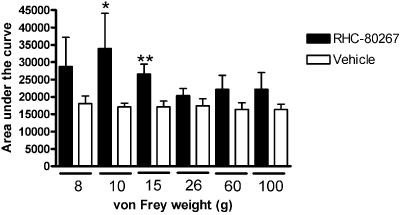054P Brighton
Winter Meeting December 2008 |
Inhibition of DAG lipase increases mechanically-evoked responses of spinal neurones in vivo
Devi Rani Sagar, David Kendall, Victoria Chapman
University of Nottingham, Nottingham, UK
Endocannabinoids are present in the spinal cord, and it has been previously demonstrated that their levels are increased in some chronic pain states (Petrosino et al., 2007). Previous studies have shown that inhibition of endocannabinoid catabolism can increase endocannabinoid levels and produce anti-nociception (for review see, Jhaveri et al., 2007). RHC-80267 (1,6-bis-(cyclohexyloximinocarbonylamino)-hexane) is a potent inhibitor of diacyglycerol lipase (DAG lipase; Sutherland and Amin, 1982), one of the enzymes responsible for the synthesis of the endocannabinoid 2-arachidonoylglycerol (2-AG; Bisogno et al., 1999).
The aim of the present study was to investigate the effect of spinal RHC-80267 on innocuous and noxious mechanically-evoked responses of spinal neurones in naïve rats in vivo.
Extracellular single unit recordings of wide dynamic range (WDR) dorsal horn neurones (Laminae V and VI) were made in anaesthetised (1.5% isoflurane, 66% N2O, 34% O2) adult male Sprague Dawley rats (250-300g). Effects of a spinal administration of the DAG lipase inhibitor RHC-80627 (10-50μg/50μl) or vehicle (3% Tween80 in phosphate buffered saline) on mechanically (8-100g) evoked responses of WDR neurones were studied.
RHC produced a facilitation of 8-15g evoked responses which were significantly different compared to vehicle application for 10 and 15g-evoked responses (p<0.05 and p<0.01 respectively, n=5 neurones in 5 rats for all groups; Figure 1)

Figure 1. Area-under-the-curve analysis of the effects of RHC-80267 or vehicle on mechanically-evoked responses of WDR neurones. Data are expressed as mean area under the curve ± s.e.mean
Statistical comparison between effects of RHC-80267 and vehicle were carried out using a Mann Whitney test. * p<0.05, **p<0.01.
These results are supported by previous data demonstrating that spinal administration of the cannabinoidCB1 receptor antagonist AM251 can produces a facilitation of low-weight mechanically-evoked responses in sham-operated rats in a similar paradigm (Jhaveri et al., 2008) indicating the presence of an endogenous cannabinoid tone modulating nociceptive responses. Future analytical studies will investigate the effects of spinal RHC-80267 on endocannabinoid levels in the spinal cord.
Bisogno et al., (1999) J Neurochem., 72: 2113-2119
Jhaveri et al., (2008) International Association for the Study of Pain 12th World Congress on Pain, Glasgow Scotland. PW065
Jhaveri et al., (2007) Br J Pharmacol. 152:624-632
Petrosino et al.,(2007) Neuropharmacol. 52:415-422
Sutherland and Amin (1982) J. Biol.Chem., 257; 14006-14010
|


